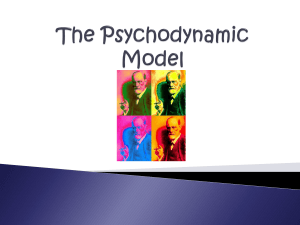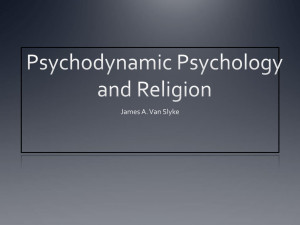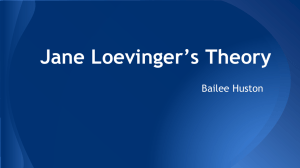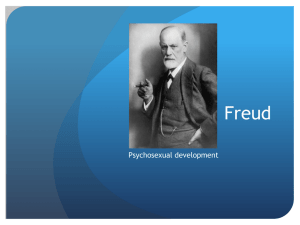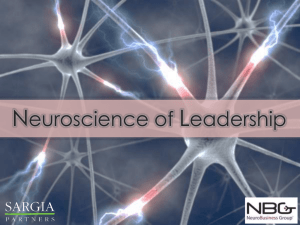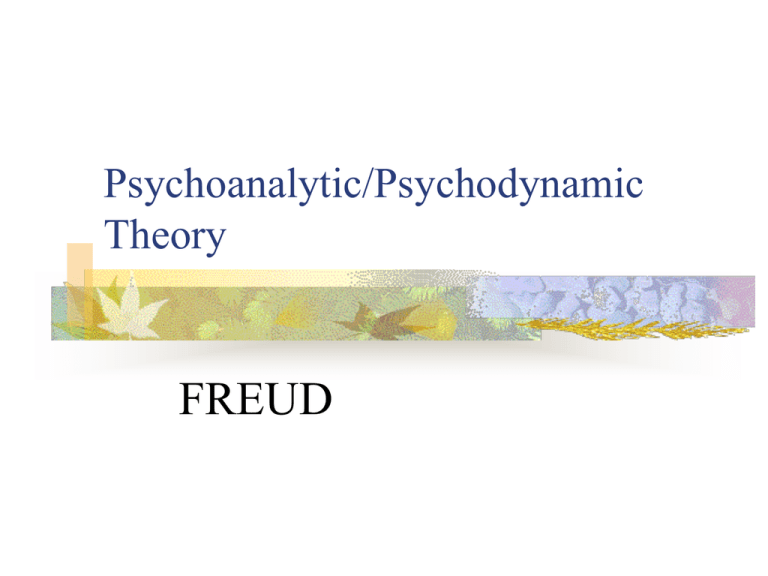
Psychoanalytic/Psychodynamic
Theory
FREUD
2
Psychoanalysis
Theory of Personality
Method of Therapy
Technique of Investigation
Freud developed his theories based on
intensive clinical studies of individual
cases – women with hysterical symptoms
3
Brief History 1856-1939
1881 – Practices medicine in neurology
and nervous diseases
Basic research in “nerve” cells in simple animals
neurons- bdng. blocks brain
Breuer “talking cure” Anna O.
Under hypnosis connect symptoms to earlier traumas
that are repressed
Re-lives the early emotional experience and
symptoms disappear - catharsis
4
Hypnosis vs. Free Association
How to make the patient remember the
“forgotten” traumatic experience while
awake.
Freud assumes that all behavior is
purposeful, therefore,
Patient verbalizations, interpreted by the
analyst, will lead to the repressed material
5
Concept of Humans
Humans are an energy system
Basic source of energy – Instincts
States of excitation in the body that seek
expression and tension reduction
Biologically rooted
Behavior is purposeful--determined by
instinctual forces
Instincts are governed by the pleasure
principle
6
Instinctual energy exists in a state of
tension created by opposing forces
EROS
Life Instinct Preservation of
self and species
THANATOS Death instinct Source of
aggression and drive to die
7
Instinct may be satisfied
By external objects – Real or displaced
The object is energized by the instinct
In fantasy
By becoming fused in one action
Eating – aggression and self-preservation
8
Instinct gratification vs. society’s
demands for restraint
Direct Gratification – Possible sometimes
Sublimation – positive and culturally
valued activities
Neurosis – maladaptive but more
acceptable ways to the person or to society
9
Levels of Awareness: Unconscious,
Pre-conscious, Conscious
Unconscious
A-logical
Disregards time and space
Symbolic language
Many ideas may be condensed in one
Part = Whole
One whole = several objects
10
Clinical evidence for postulating
the unconscious
Dreams
Slips of the tongue
Posthypnotic suggestions
Material derived from free-association
Material derived from projective techniques
Symbolic content of psychotic symptoms
NOTE: consciousness is only a thin slice of the
total mind
11
Implications of the Unconscious
Significant part of our behavior is
controlled by forces out of our awareness
Psychic energy is used to
find acceptable ways to express unconscious
ideas and wishes
or
to keep them repressed
12
Structure of Personality
Three psychic structures or mental
functions that are grouped according to the
role they play in the dynamic conflict
ID
EGO
SUPER EGO
13
THE STRUCTURE OF THE PSYCHE
New Introductory
Lectures on
Psychoanalysis
Freud, 1933
Pcpt.-cs.: Perceptual
consciousness
14
ID
Unconscious Biological Component
Base of instinctual life
Source of drive energy – Libido
Guided by pleasure principle, seeks
gratification of instinct in action or fantasy
A-social – no regard for social norms
Life and death drives co-exist in dynamic
tension
15
EGO
Conscious Aspect of Self –Reality Principle
Acts in the external world – behaviors
Site of perceptual cognitive skills
Mediates between Id and Super-Ego
Able to separate wish from fantasy
Tolerates tension and is able to compromise
Changes with time
16
SUPER EGO
Learned Aspect of Self, Ego ideal
Both conscious and unconscious
Moral aspect, guided by ideals
Lacks reality testing
Actions = Thoughts
Black –White judgments – no ability to
compromise
Formed by Ego out of the Id
17
18
Theory of Psychological Development
Focuses on the development of the
instincts, therefore it is rooted in biology
Genetic approach – earlier stages are
important determinants of later stages
It is a rather abstract aspect of the theory
19
The Development of Personality
ORAL STAGE
Related to later mistrust and rejection issues
ANAL STAGE
Ages 1-3
Related to later personal power issues
PHALLIC STAGE
First year
Ages 3-6
Related to later sexual attitudes
Theory and Practice of Counseling and Psychotherapy - Chapter 4 (1)
20
The Development of Personality
LATENCY STAGE
A time of socialization
GENITAL STAGE
Ages 6-12
Ages 12-60
Sexual energies are invested in life
21
Erikson’s Stages of Development
Trust vs. Mistrust First Year
Autonomy vs. Shame and doubt
Initiative vs. Guilt
Industry vs. Inferiority
Identity vs. Role Confusion
Intimacy vs. Isolation
Generatively vs. Stagnation
Integrity vs. Despair
Oral
1-3
3-6
6-12
12-18
18-35
35-60
60+
22
Process of Psychic Life
Investment of energy for:
Object gratification
Repression of drives and desires
23
Process of Psychic Life
Conflict is experienced for two main
reasons:
Internal
forces in dynamic opposition
Relationship with figures of authority
and/or rigid super ego engender
perceptions of danger which lead to
repression of impulses and frustration
Conflict leads to Anxiety
24
Anxiety
Painful emotional experience
Alerts Ego of danger
Emerges from the emotional repetition
of the trauma
25
Anxiety
The conflict may be between
ID-Ego
Ego fears being
overwhelmed by Id
ID-Super Ego Guilt, self-condemnation
Ego-Ego
Aware vs. repressed Ego
Desire/want versus fear, sense of threat
26
THE STRUCTURE OF THE PSYCHE
Freud, 1933
New Introductory
Lectures on
Psychoanalysis
27
Ego-Defense Mechanisms
Are normal behaviors which operate on an
unconscious level to deny or distort reality
Help the individual cope with anxiety and
prevent the Ego from being overwhelmed
Have adaptive value if they do not become
a style of life to avoid facing reality
Theory and Practice of Counseling and Psychotherapy - Chapter 4 (4)
28
Defense Mechanisms
Repression
Denial
Reaction formation
Projection
Displacement
Rationalization
Regression
Intellectualization
Sublimation
Introjection
Identification
Compensation
29
Ego Strength or Resiliency
The more the EGO needs to use repression
to maintain equilibrium:
The more rigid and defended it will be, and
The less capable to deal with the demands of
the ID and the outside WORLD and the
criticisms of the SUPER EGO
30
Theory of Psychopathology (1/2)
When conflicts occur in early life, a
fixation or “freezing” of development
occurs
Person will have difficulty with the tasks of
the stage in which conflict occurred
Conflicts at one stage influence the
development of subsequent stages
31
Theory of Psychopathology (2/2)
The experience of the conflict (then and
now) generates ANXIETY which
Results in the development of
MECHANISMS OF DEFENSE that help
the Ego deal with the anxiety
Overuse of the defenses results in
SYMPTOMS -- disguised expression of
repressed emotions and impulses
32
Stage of Development and Trauma
4/5 years +
2/3 years
First year
Neurosis
Obsessive/compulsive
Psychosis, Narcissistic,
Borderline
Ego can handle the anxiety using the
defenses, or
Ego is overwhelmed and person regresses
to primitive, primary processes of thinking
33
]
Example Early Conflict
Child receives inadequate, inconsistent care
in infancy, responds with:
Frustration and anger
Perception of needs as bad, self as bad
Fear of abandonment from caretaker
Part of the Ego that perceives the unmet
needs and the negative feelings will be
repressed or denied
34
In adulthood, situations that elicit desire to be close to
others, to have others take care of one’s needs, elicit
Anxiety related to the old feelings of:
Frustration and anger
Perception of needs as bad, self as bad
Fear of abandonment
Symptom: Difficulties in interpersonal
relations -- product of mechanisms of defense (e.g.
denial, reaction formation, projection, displacement, sublimation)
used to avoid the anxiety generated by these negative
feelings
35
Psychodynamic Perspective
Conflict between conscious (want to get close, be taken
care of) and repressed aspects of the Ego (sense of self
as bad; fear of rejection)
Potential Defense Mechanisms
Displacement: anger, frustration towards parental
figures and self is directed towards significant others
Projection/Sublimation: projects on others
repressed desires of being taken care of- becomes
supreme caretaker
Reaction formation: develop a super-independent
persona
36
Therapeutic Objectives
Bring the unconscious conflict to
awareness -- Resistance
Corrective emotional experience
Re-live past painful experiences under more
favorable conditions to get a better solution to
the conflict
The process involves
Catharsis – release of blocked emotions
Insight- awareness and understanding of
emotional reactions and use of defenses
37
Psychoanalytic Techniques
Free Association
Client reports without censoring feelings &
thoughts
Dream Analysis
“Royal road to the unconscious” to bring
unconscious material to light
38
Psychoanalytic Techniques
Transference
The client reacts to the therapist as he did earlier to
significant others
To re-experience repressed memories and feelings
ANALYSIS OF TRANSFERENCE — allows the client to
achieve insight into the influence of the past
Interpretation to lead to Insight
Therapist points out, explains, and teaches the
meanings of what is revealed- connect unconscious
to conscious- which leads to insight
39
Counter-Transference
Therapists’ reactions toward the client is
based on unconscious issues -- that may
interfere with objectivity
40
Resistance
Anything that works against the progress of therapy;
prevents the production of unconscious material
avoid dealing with painful emotions
Defense Mechanisms: Denial, intellectualization,
projection, rationalization
Canceling appointments, terminating therapy prematurely,
having nothing to say
Confrontation and Analysis of Resistance
Helps client see the secondary gain of behavior
Theory and Practice of Counseling and Psychotherapy - Chapter 4 (7)
41
Markers Ego Resiliency vs. Brittleness
Confidence Optimism
•
•
•
•
Has social poise and presence
Responds to humor
Calm, relaxed in manner
Feels a lack of personal meaning
•
•
•
•
•
•
Basically anxious
Vulnerable, fearful
Tends to ruminate
Feels cheated, victimized by life
Maladaptive under stress
Is self-defeating
Productive and Autonomous Activity
• Is productive; gets things done
• Values own independence
• Gives up; withdraws from adversity
42
Markers Ego Resiliency vs. Brittleness
Interpersonal Warmth and Insight
• Has warmth; is compassionate
• Insight into own motives and
behaviors
• Arouses liking and acceptance
• Perceptive of interpersonal cues
• Sees to heart of problems
• Dependable and responsible
• Denies unpleasant experiences
• Over-reactive to frustrations
Skilled Expressiveness
• Skilled in social techniques
• Initiates humor
• Is emotionally bland
• Does not vary roles
• Uncomfortable with uncertainty
43
44
Limitations Freud’s Theory
Reductionism and theory of instincts
Concepts are difficult to observe and
measure empirically
Limited use in predicting behavior: goes
from the adult back to the child
Socio-cultural limits
Based on women from higher SES
Victorian issues of sex and morality
Outdated gender role perspectives
45
Contributions
Moved the study of “nervous
diseases” to the realm of the
psychological
Discovery of the Unconscious
Comprehensive complex theory
Has generated much study and
continues to evolve
Basic tenets have been incorporated in
modern theories
46
Anatomy of the Brain & the Unconscious
47
Amygdala – receives
perceptual stimulus
directly; storages
emotional memories
Prefrontal cortexdeclarative memoryconscious recollections
of past events, things,
persons
48
Pathways of Emotions: Fear
The amygdala lets us
react almost
instantaneously to the
presence of a danger.
Often we startle first,
and then realize what
frightened us.
49




